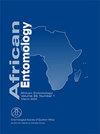In vitro liquid mass production of a South African isolate of Heterorhabditis zealandica
IF 1.2
4区 农林科学
Q3 ENTOMOLOGY
引用次数: 0
Abstract
Developing repeatable protocols for the in vitro liquid mass production of entomopathogenic nematodes (EPNs) is a difficult task and depends on the nematode species being cultured. Of critical importance is the establishment of a monoxenic population of nematodes as a stock culture for optimisation and experimental purposes. Establishing a new stock inoculum culture flask of pure infective juveniles (IJs) is challenging, particularly for the Heterorhabditis species, due to their affinity for developing into an amphimictic second generation that does not copulate in liquid culture flasks. Developing mass production protocols for multiple EPNs is advisable because different pest insects are susceptible to different species of EPN. This study attempted to mass-produce a South African isolate of Heterorhabditis zealandica and its symbiotic bacteria, Photorhabdus thracensis, using in vitro liquid culture technology methods previously developed for Steinernema species. The results indicate that the pre-culture protocols developed for Steinernema species are applicable to a H. zealandica isolate. Moreover, the results, in terms of the protein source optimisation experiments, confirm that different EPN species have different culture conditions and nutrient requirements, with H. zealandica seeming to prefer soy-based protein instead of egg yolk, having higher recovery and producing more hermaphrodites, using soy protein. This study illustrates the importance of developing dependable and infallible preculture methods, prior to the flask mass production process.南非异芽孢菌的离体液体批量生产
开发可重复的体外液体批量生产昆虫病原线虫(EPNs)的方案是一项艰巨的任务,这取决于所培养的线虫种类。最重要的是建立一个单性线虫种群,作为优化和实验目的的种群培养。建立一个新的纯感染性幼虫(IJs)的后备接种培养瓶是具有挑战性的,特别是对于Heterorhabditis物种,因为它们很容易发育成两性生殖的第二代,而不是在液体培养瓶中交配。制定多种EPN的大规模生产方案是可取的,因为不同的害虫对不同种类的EPN敏感。本研究试图利用体外液体培养技术,采用先前为Steinernema物种开发的方法,大规模生产南非的zealandica Heterorhabditis及其共生细菌Photorhabdus thracensis。结果表明,为施泰纳氏菌种制定的预培养方案适用于新西兰菌株。此外,在蛋白质来源优化实验方面,结果证实了不同EPN物种具有不同的培养条件和营养需求,其中西兰花似乎更喜欢大豆蛋白而不是蛋黄,使用大豆蛋白回收率更高,产生更多的雌雄同体。这项研究说明了在烧瓶大规模生产过程之前,开发可靠可靠的预培养方法的重要性。
本文章由计算机程序翻译,如有差异,请以英文原文为准。
求助全文
约1分钟内获得全文
求助全文
来源期刊

African Entomology
生物-昆虫学
CiteScore
2.00
自引率
0.00%
发文量
17
审稿时长
6-12 weeks
期刊介绍:
African Entomology (ISSN 1021-3589 – print / 2224-8854 – online) replaced the old Journal of the Entomological Society of Southern Africa in 1993. A single volume consisting of two issues (March and September) is published annually. The journal is indexed in all major abstracting journals
African Entomology is a peer reviewed scientific journal that publishes original research articles and short communications on all aspects of entomology, with an emphasis on the advancement of entomology on the African continent.
 求助内容:
求助内容: 应助结果提醒方式:
应助结果提醒方式:


